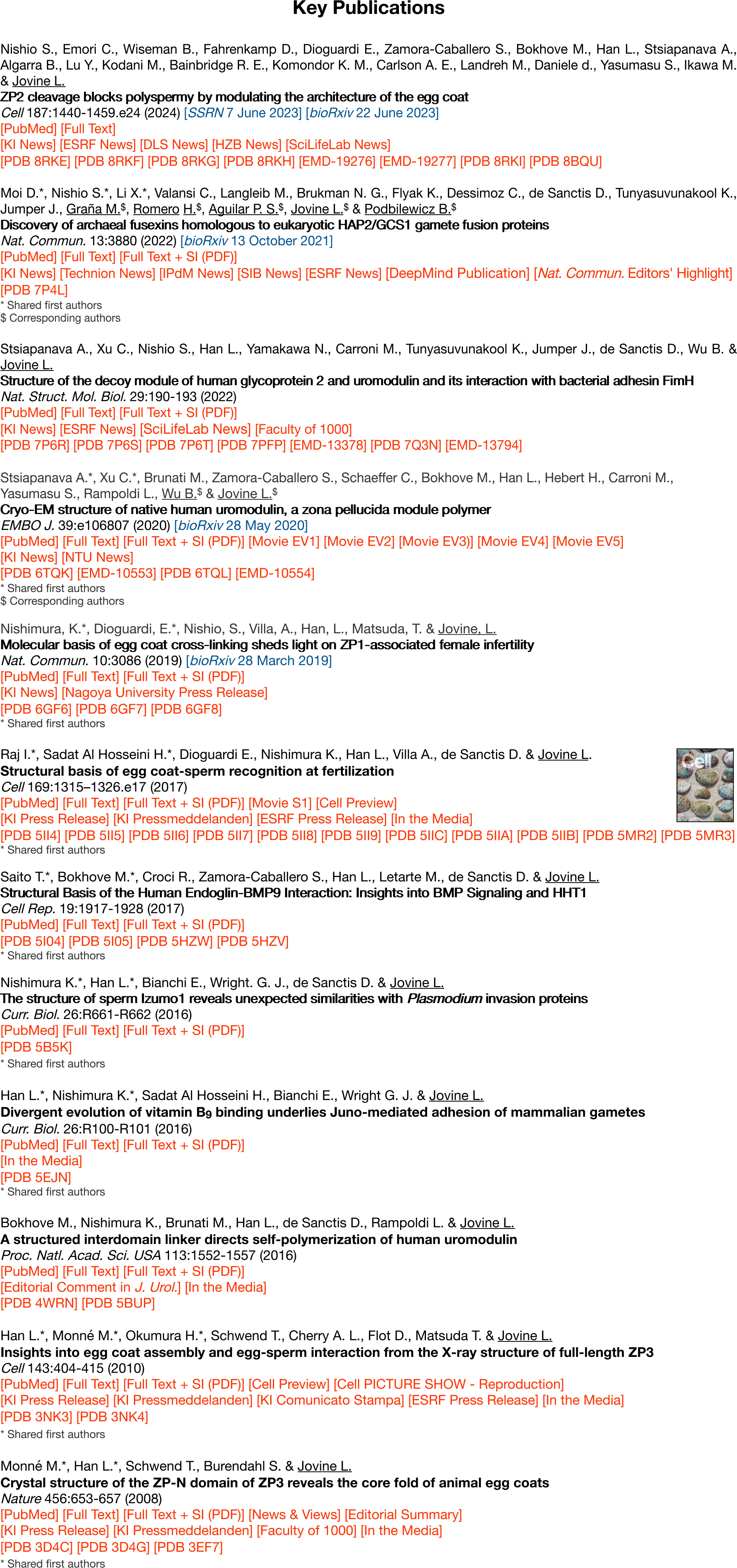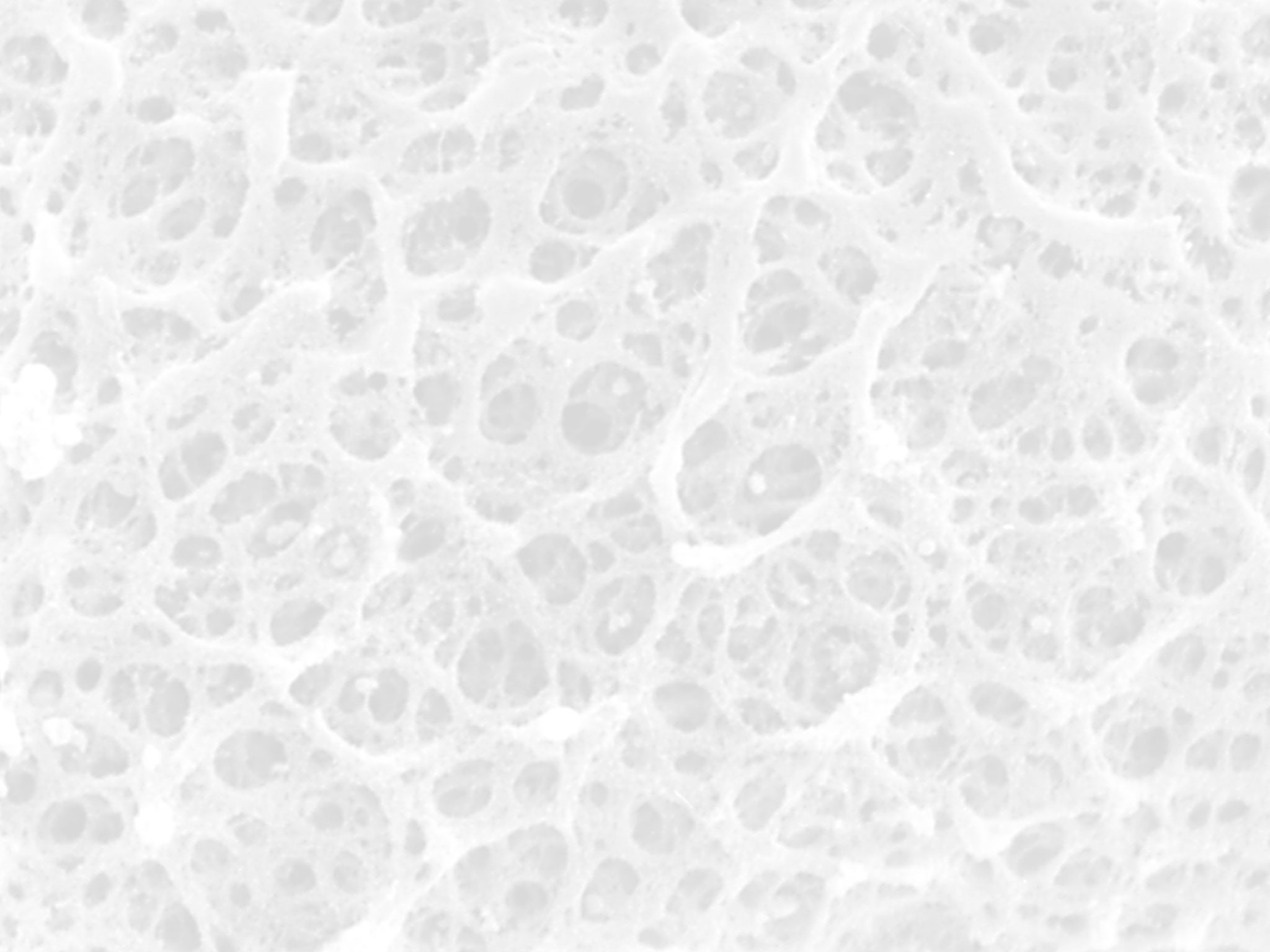| By marking the very beginning of a new individual, egg-sperm interaction at fertilization is a crucial step in the life cycle of all sexual organisms. Human sperm was first visualized at the end of the 17th century, and scanning electron microscopy pictures taken in the 1960's captured the collective imagination by offering low resolution glimpses of the encounter between human gametes. However, the molecular details underlying the species-restricted embrace between germ cells remained until recently completely obscure. The ultimate aim of our laboratory is to use structural biology to provide a definitive answer to this fundamental biological problem with important evolutionary implications. Our research focuses on the zona pellucida (ZP), a thick, specialized extracellular matrix that surrounds mammalian eggs and plays essential roles in oogenesis, fertilization and pre-implantation development. Depending on the species, the ZP contains 3 or 4 glycoprotein subunits (denominated ZP1-4) that assemble into micrometer-long filaments using a conserved polymerization module of ~260 amino acids, the so-called ZP domain. Additional regions contained within individual ZP subunits are responsible for their specific functions in the fertilization process. For example, ZP3 and ZP2 have long been suggested to mediate interaction with sperm. At the same time, the polymerization and receptor activities of ZP subunits are intimately connected to each other, not only because their supramolecular arrangement ensures that enough receptor molecules are concurrently presented to the head of sperm, but also because post-fertilization changes in the overall structure of the ZP have an important role in the block to polyspermy. This interplay between structure and function is further highlighted by the observation that mice lacking ZP3 or ZP2 do not have a ZP and are completely infertile, and that alterations of the structure of the ZP as well as mutations of ZP genes are implicated in human infertility. ZP modules are also found in egg coat proteins from other animal classes such as sperm receptor VERL, a giant multi-repeat component of the vitelline envelope of marine mollusk abalone - a classic model system of invertebrate fertilization. Moreover, ZP modules have been identified in many other extracellular proteins from multicellular eukaryotes that are located in different tissues and carry out a variety of biological functions unrelated to fertilization. These include structural components of cuticles and houses (CUT1-6; Oikosin 6), defense molecules with anti-microbial activity (urinary uromodulin (UMOD)/Tamm-Horsfall protein (THP); salivary agglutinin and lung glycoprotein-340), proteins involved in mechanotransduction (inner ear alpha- and beta-tectorin; NompA) or maintenance of mechanical tension (Dumpy), molecules playing roles in morphogenesis of wings and branched organs (Miniature and Dusky; Piopio) as well as differentiation of epithelia (hensin and vomeroglandin), and proteins involved in BMP and TGF-beta signaling (endoglin/CD105 and TGF-beta receptor III/betaglycan). Mutations in the ZP module of these proteins are linked to a number of severe human pathologies, such as urinary and vascular diseases, non-syndromic deafness and cancer. Our laboratory has a long-term interest in determining how the ZP module common to this large family of proteins drives their assembly into filaments and matrices, and how combination of these supramolecular structures to additional domains results in the specific biological functions of the individual proteins, particularly in relation to fertilization. Towards this goal, we have solved crystal structures of ZP3 (Monne' et al. Nature 2008; Han et al. Cell 2010) and the polymerization regions of ZP2 and UMOD (Bokhove et al. PNAS 2016). We also determined structures of endoglin - a ZP module-containing protein that does not polymerize - and its complex with key ligand BMP9 (Saito et al. Cell Rep. 2017). In parallel, we reported the structures of egg plasma membrane-anchored protein Juno and sperm surface protein Izumo1, whose interaction is essential for triggering the fusion of mammalian gametes (Han et al. Curr. Biol. 2016; Nishimura et al. Curr. Biol. 2016). Finally, we solved structures of the sperm-binding domains of mammalian ZP2 and mollusk VERL, as well as structures of complexes between VERL repeats and their sperm counterpart, acrosomal protein lysin (Raj et al. Cell 2017). This showed that - despite insignificant sequence similarity - sperm receptor molecules from vertebrates and invertebrates use a common "ZP-N" protein fold to interact with sperm. Moreover, it revealed how lysin and VERL interact with each other in both species-specific and non-species-specific manners. The structures of ZP3, ZP2 and Juno were the first to be reported of vertebrate proteins that are both essential for fertilization and directly involved in the interaction between gametes. Similarly, our structures of VERL/lysin complexes provided the first atomic-resolution information on how sperm recognizes the egg coat at the beginning of fertilization. To gain further insights into the molecular basis of this fundamental process, we are now targeting additional complexes between key egg-sperm recognition proteins, as well as trying to understand how structural alterations of ZP module polymers translate into human disease at the molecular level. A first example of the latter line of work is the elucidation of structures of the ZP cross-links (Nishimura et al. Nat. Commun. 2019), whose analysis revealed how mutations in ZP1 can lead to human sterility. At the same time, continuing our studies of other biomedically important ZP module proteins, we recently exploited the power of high-resolution cryo-electron microscopy to determine the structure of the native human UMOD polymer. This provided the first detailed information on the architecture of a ZP module protein filament and, together with biochemical and functional assays, suggested a molecular mechanism for the assembly of UMOD and other ZP module proteins (Stsiapanava et al. EMBO J. 2020). By combining AlphaFold2 predictions to crystallography and cryo-EM, we then further extended this work to understand how UMOD and related human glycoprotein 2 (GP2) protect us from infection by presenting specific high-mannose glycans that act as baits for bacterial invaders (Stsiapanava et al. Nat. Struct. Mol. Biol. 2022). A comparable integrative approach also allowed us to determine the structure of the first prokaryotic fusogen, archaeal Fusexin1 (Fsx1). By providing conclusive evidence that Fsx1 is homolog of class II fusion proteins from enveloped viruses as well as plant and invertebrate gamete fusogen HAP2/GCS1, this work raised the intruiging possibility that the protein may be the ancestral molecule from which viral, plant and animal fusogens derived (Moi et al. Nat. Commun. 2022). Recenty, we intersected several of the aforementioned lines of investigation and methodological approaches to unveil the molecular mechanism whereby the fertilized egg permanently blocks polyspermy - a condition that is lethal for the embryo of mammals and most other vertebrates. By solving structures of ZP2 in its intact (pre-fertilization) and cleaved (post-fertilization) state, as well as determining the first structure of a vertebrate egg coat filament, we discovered that processing of ZP2 after gamete fusion triggers the interaction between copies of the molecules that belong to different ZP filaments. This extensively cross-links the egg coat matrix, hardening it and making it physically impenetrable to additional sperm (Nishio et al. Cell 2024). As exemplified by all these studies, the research of our group relies on a comprehensive array of techniques that include molecular biology; protein production in both prokaryotic and eukaryotic systems (with a very strong focus on mammalian cell expression); protein purification, biochemical/biophysical characterization; 3D structure determination by X-ray crystallography and cryo-EM; and machine learning-assisted structural modelling. In collaboration with other laboratories, we are also performing functional studies using a variety of experimental model systems, ranging from worm to human. | |


